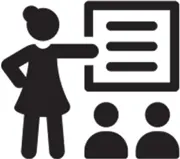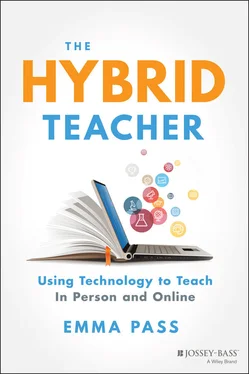Because I had little other experience teaching, I threw myself entirely into learning how to use educational technology to engage my students and differentiate instruction to meet the needs of as many learners as possible. I was also incredibly lucky to have a teacher-mentor, Larenda Norman, who supported me and encouraged me to continue learning.
A few years later when my husband had the opportunity to cover a European news circuit, we jumped at the opportunity to live in London. There, I had another lucky break in meeting my next mentor, Andy Caffrey, with whom I traveled the country and continent working as an educational technology consultant, teaching and training other teachers to use technology in their classrooms.
I currently live in my home state of Colorado, where I still work part time as an EdTech consultant through my consulting company, Empowered Edu. I also teach 7th- and 8th-grade language arts at PSD Global Academy (PGA), a public hybrid school in which students spend half of their time learning in person and half of their time learning from home.

I wanted to start with my story because the perspective of this book comes entirely from these experiences. A lot of what I write about comes not from research or interviews but the time I've spent with students.
Everything I do in education is for them.
A NOTE ON ACCESS AND EQUITY
I want to address the privilege assumed in this book.
My experiences in hybrid teaching are based largely on my current position as a teacher at PGA. We live in a well-funded, predominantly White city where we are able to provide laptop devices, 1-1, to all of the students in our school and district.
Further, many of the students who come to our hybrid school have a stay-at-home or work-from-home parent to support and encourage their learning during online/remote days. There are exceptions, but we are ultimately teaching in a position of great privilege.
This type of digital access and support is not a reality for many schools and districts that are disproportionately made up of low-income, rural, Black, Latinx, and/or Native American populations.

I say this to emphasize the existence of a “digital divide” in our country, which needs to be bridged so that we provide access to technology, Wi-Fi, professional development, and after-school/at-home support to every student, school, and district nationwide.
Shining a light on the issue is only the first step, and it is not enough. People in a position of privilege can choose to simply look away because it does not affect them. If you are in such a position, choose to turn toward the light, then act. There are several immediate steps we can take to help:
Sign a petition on Change.orgdemanding action to provide internet access to low income families.
Contact your state representatives to request additional funding to public education, specifically to address the digital divide.
Donate to ConnectHomeUSA.org, a company working to bridge the digital divide in government assisted housing, or to DonorsChoose.org, where you can provide resources directly to teachers and classrooms nationwide.
I have done my best to explore practical and tangible options for addressing access to technology in the section “Access to Technology” in Chapter 14.
With great hope and effort, we will achieve digital access equity in our country.
Teach on,
Emma
Items in boldin the text are listed here in the Resources.
2016 Arizona State University study on educational technology— http://files.eric.ed.gov/fulltext/ED577147.pdf.
Chapter 1 Synchronous and Asynchronous Learning
I never teach my pupils; I only attempt to provide the conditions in which they can learn.
—Albert Einstein
When we talk about teaching and learning, especially in the context of a digital learning environment, we are typically thinking about it in one of two ways:
 |
Synchronous LearningTeaching and learning occur together, simultaneously. This can happen in-person or online. |
 |
Asynchronous LearningStudents access learning at different times and work through it at their own pace. |
Synchronous learning is what typically happens in a traditional brick-and-mortar school; it's what we think of when we hear “teaching.” The teacher stands in front of the class and delivers instruction, and the students receive the information simultaneously. Then students practice and apply their learning within the time constraints of the class period.
However, it's important to note that synchronous learning can also be conducted remotely over a video conferencing platform like Zoom or Google Meet in a remote or hybrid learning scenario.
In contrast, asynchronous learning is typically prebuilt and posted for students on a learning management system (LMS) to access within the time constraints of a day, week, or unit.
Many 100% online schools are entirely asynchronous, where students have access to the entirety of their prebuilt course work, unit, or module, and they work through it at their own pace.
Hybrid schools often use a combination of both. Our PSD Global Academy (PGA) middle school schedule, for example, follows this system for delivering instruction:
| Monday |
Tuesday |
Wednesday |
Thursday |
Friday |
| Remote Asynchronous |
On-Campus Synchronous |
Remote or On-Campus Asynchronous |
On-Campus Synchronous |
Remote Asynchronous |
However, there are other methods for delivering synchronous/asynchronous instruction that you can read about in The Administrators' Appendix. These examples are found in schools that are attempting to teach synchronously to students who are both in the classroom and at home by livestreaming their lessons (concurrent instruction).
I believe there are benefits to both synchronous and asynchronous instruction, and both should be adopted as instruction methods regardless of whether you're full-time brick and mortar, hybrid, or remote.

Конец ознакомительного фрагмента.
Текст предоставлен ООО «ЛитРес».
Прочитайте эту книгу целиком, купив полную легальную версию на ЛитРес.
Безопасно оплатить книгу можно банковской картой Visa, MasterCard, Maestro, со счета мобильного телефона, с платежного терминала, в салоне МТС или Связной, через PayPal, WebMoney, Яндекс.Деньги, QIWI Кошелек, бонусными картами или другим удобным Вам способом.

















